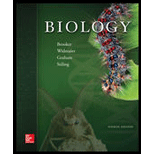
Concept explainers
Introduction: Species interact with each other in the ecosystem for their survival. These interactions can be understood by the food chains and food webs where species depend on each other for certain nutritive benefits. However, these interactions can be beneficial for one and harmful to others, or sometimes beneficial for both.
Answer to Problem 1TY
Correct answer: In an interaction where species is benefitted, and the other species is not harmed is known as commensalism. Hence, the correct answer is option d.
Explanation of Solution
Reason for correct answer:
Commensalism is the type of species interaction in which one is benefited, and the other species remain unharmed or unaffected. This type of interaction is depicted as ‘+/0’, where ‘+’ sign refers to as benefits, and ‘0’ refers to as unaffected or experiences no loss.
Option d is given as, “Commensalism”.
The interaction in which one is benefitted and the other species is not harmed is called commensalism. Hence, option d is correct.
Reasons for incorrect answers:
Option a. is given as, “Mutualism”.
It is a symbiotic relationship in which both species are mutually benefitted. This type of interaction is depicted as ‘+/+’. Hence, option a. is incorrect.
Option b. is given as, “Amensalism”.
In this type of interaction, one is harmed, and another is not affected. It is depicted as ‘-/0’. This interaction is generally observed in predation. Hence, option b is incorrect.
Option c. is given as, “Parasitism”.
In this type of interaction, parasites are benefited while the host is affected. It is depicted as ‘+/-‘. The parasite kills the host cells and utilizes the
Option e. is given as, “Mimicry”.
Mimicry is not an interaction; it is an adaption. In this type of adaptation, the species adapt or acquire some features of other ones in order to protect themselves from predators. Hence, option e is incorrect.
Hence, options a, b, c, and e are incorrect.
Species interact with each other to survive, and it is natural. These interactions can be understood by the food chains and food webs where species interact to get food.
Want to see more full solutions like this?
Chapter 57 Solutions
Biology
- A symbiotic association in which organisms are beneficial to one another is known as (a) predation (b) interspecific competition (c) intraspecific competition (d) commensalism (e) mutualismarrow_forwardWhich of the following species interaction types are positive for one participating species, and negative for the other species. Please select all correct answers. a.) Parasitism b.) Amensalism c.) Commensalism d.) Predation e.) Mutualismarrow_forwardThe association which involves the exchange of nutrients between two species is referred to as: -commensalism -mutualism -predation -antagonsimarrow_forward
- What is the interaction exhibited by the organisms named cat and rat? a.)mutualism b.)commensalism c.)predation d.)parasitism e.)competitionarrow_forwardThe bluestreak cleaner wrasse is a fish that inhabits coral reefs. These fish eat parasites off of larger fish. The larger fish benefit from increased health. In return, the wrasse receive nutrition and protection from the larger fish. What type of interaction is this? a) Predation b) Mutualism c) Parasitism d) Commensalismarrow_forwardWhat is the interaction exhibited by the organisms named sea anemone and clownfish? a.)mutualism b.)commensalism c.)predation d.)parasitism e.)competitionarrow_forward
- Which of the following regarding species interactions is INCORRECT? a) The net effects of a mutualism on each participant is a fixed characteristic of the interaction, and is rarely influenced by external factors. b) Reciprocal parasitism is an accurate way of describing many mutualistic interactions. c) The Lotka-Volterra competition model accounts for the effects of both interspecific and intraspecific competition.arrow_forwardDefine the following terms and give one example for each:(a) Commensalism(b) Parasitism(c) Camouflage(d) Mutualism(e) Interspecific competitionarrow_forwardHow can a commensalism become a mutualism? a. A commensalism cannot become a mutualism. b. An interaction that was once harmful to one species becomes beneficial to both species. c. An interaction that was once harmful to both species becomes beneficial to one species. d. An interaction that was once beneficial to both species becomes beneficial to only one species. e. An interaction that was once beneficial to one species becomes beneficial to both species.arrow_forward
- Which of the following is true? a. predation is a form of parasitism b. parasitism is a form of predation c. parasitism is detrimental to both organisms d. predation is always interspecificarrow_forwardWhich of the following rows correctly describes the difference between predation and parasitism? Select one: a. Predation Parasitism The host species is killed to benefit the other species. The host species is not killed, but its life is barely sustained to benefit the other species. b. Predation Parasitism The host species is unharmed, and its life is sustained to benefit the other species. The host species killed or barely left alive to benefit the other species. c. Predation Parasitism The host species is not killed, but its life is barely sustained to benefit the other species. The host species is not killed, but its life is barely sustained to benefit the other species. d. Predation Parasitism The host species killed or barely left alive to benefit the other species. The host species is unharmed, and its life is sustained to benefit the other species.arrow_forwardA relationship between two species where one species benefits and the other is neither hurt nor helped is known asa. parasitism.b. commensalism.c. mutualism.d. competition.arrow_forward
 Concepts of BiologyBiologyISBN:9781938168116Author:Samantha Fowler, Rebecca Roush, James WisePublisher:OpenStax College
Concepts of BiologyBiologyISBN:9781938168116Author:Samantha Fowler, Rebecca Roush, James WisePublisher:OpenStax College Biology (MindTap Course List)BiologyISBN:9781337392938Author:Eldra Solomon, Charles Martin, Diana W. Martin, Linda R. BergPublisher:Cengage Learning
Biology (MindTap Course List)BiologyISBN:9781337392938Author:Eldra Solomon, Charles Martin, Diana W. Martin, Linda R. BergPublisher:Cengage Learning


